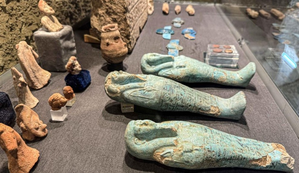Luxor, Jan 9: Archaeologists in Egypt have unearthed significant finds near Luxor, including parts of a temple linked to Queen Hatshepsut, the Ministry of Tourism and Antiquities said. A team led by Zahi Hawass on Wednesday discovered a well-preserved section of the Valley Temple’s foundations, which served as the main gateway to Hatshepsut’s funerary temple, dating back to the 18th Dynasty (around 1539-1292 BC), reports Xinhua news agency.
The excavation yielded over 1,000 decorated blocks and fragments with detailed carvings and inscriptions, considered rare examples of sculpture from Hatshepsut’s reign and that of her successor, Thutmose III. The ministry said these inscriptions are the most complete found from the temple, which was deliberately destroyed during the Ramesside Period (around 1292-1077 BC). More than 100 limestone and quartzite tablets bearing Hatshepsut’s royal cartouches (nameplates) were also found.
These, along with other foundation deposits, confirm Hatshepsut’s ownership of the temple. The team also uncovered rock-cut tombs and artefacts from the Middle Kingdom (around 1938-1630 BC), including a tomb belonging to “the Overseer of the Palace” of Queen Tetisheri from the 17th Dynasty (around 1630-1540 BC). Burial shafts from the same period, an extensive necropolis, and bronze coins from the Ptolemaic Period (the last dynasty of ancient Egypt) were also discovered. Abdel-Ghaffar Wagdy, Director General of Luxor Antiquities, told Xinhua that the discoveries, supported by the Ministry, would “undoubtedly help attract more tourists.” Last year in November, an Egyptian-American archaeological team unearthed the first Middle Kingdom-era burials at the Assasif cemetery near Luxor.
The discovery spanned the period from 2055 BC to 1650 BC and is expected to provide new insights into burial practices during the 12th and early 13th dynasties of ancient Egypt. Excavators found 11 graves containing skeletal remains of men, women, and children, suggesting a multi-generational family burial site.
